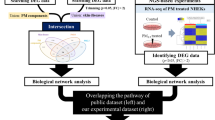Abstract
Background
Particulate matter (PM)2.5 is a concern for public health nowadays. Although few studies have reported the skin diseases associated with PM2.5, its effects on keratinocytes have yet to be elucidated.
Objective
The goal of this experiment was to analyze and identify the changes of gene expression in PM2.5-treated keratinocytes using RNA-sequencing (RNA-Seq) data.
Results
PM2.5-treated keratinocytes exhibited changes in cell cycle-related genes as well as genes involved in DNA replication, endoplasmic reticulum (ER) stress, intrinsic apoptosis, and immune response. A total of 669 genes showed changes in gene expression in PM2.5-treated keratinocytes, including 304 upregulated and 365 downregulated genes.
Conclusion
Unlike other studies investigating skin disorders associated with PM2.5, our study found the mechanism of apoptosis suppression in keratinocytes. The findings may provide a novel insight into the management of chronic skin diseases in relation to PM2.5.




Similar content being viewed by others
References
Abdel-Shafy HI, Mansour MS (2016) A review on polycyclic aromatic hydrocarbons: source, environmental impact, effect on human health and remediation. Egypt J Pet 25:107–123
Abdulghani J, El-Deiry WS (2010) TRAIL receptor signaling and therapeutics. Expert Opin Ther Targets 14:1091–1108
Banno T, Gazel A, Blumenberg M (2004) Effects of tumor necrosis factor-alpha (TNF alpha) in epidermal keratinocytes revealed using global transcriptional profiling. J Biol Chem 279:32633–32642
D’Erme AM et al (2015) IL-36gamma (IL-1F9) is a biomarker for psoriasis skin lesions. J Invest Dermatol 135:1025–1032
Ewa B, Danuta MS (2017) Polycyclic aromatic hydrocarbons and PAH-related DNA adducts. J Appl Genet 58:321–330
Gentleman RC et al (2004) Bioconductor: open software development for computational biology and bioinformatics. Genome Biol 5:R80
Gonzalez C, Choquette S, NIST (2016) Certificate of Analysis SRM2786 - Fine Atmospheric Particulate Matter (Mean Particle Diameter < 4 μm). National Institution of Standard Technology (NIST). https://wwws.nist.gov/srmors/certificates/2786.pdf
Hetland RB et al (2004) Release of inflammatory cytokines, cell toxicity and apoptosis in epithelial lung cells after exposure to ambient air particles of different size fractions. Toxicol Vitro 18:203–212
Huang DW et al (2007) DAVID bioinformatics resources: expanded annotation database and novel algorithms to better extract biology from large gene lists. Nucleic Acids Res 35:W169–W175
Joo DH et al (2015) Benzo (a) pyrene represses melanogenesis in B16F10 mouse melanoma cells. Mol Cell Toxicol 11:349–355
Kanehisa M, Sato Y, Kawashima M, Furumichi M, Tanabe M (2016) KEGG as a reference resource for gene and protein annotation. Nucleic Acids Res 44:D457–D462
Kim KH, Kabir E, Kabir SJE (2015) A review on the human health impact of airborne particulate matter. Environ Int 74:136–143
Kim H-J et al (2017) Transcriptome analysis of airborne PM2. 5-induced detrimental effects on human keratinocytes. Toxicol Lett 273:26–35
Li HM, Xiao YJ, Min ZS, Tan C (2018) Identification and interaction analysis of key genes and microRNAs in atopic dermatitis by bioinformatics analysis. Clin Exp Dermatol 44:257–264
Magnani ND et al (2016) Skin damage mechanisms related to airborne particulate matter exposure. Toxicol Sci 149:227–236
Ovrevik J et al (2010) Differential effects of nitro-PAHs and amino-PAHs on cytokine and chemokine responses in human bronchial epithelial BEAS-2B cells. Toxicol Appl Pharmacol 242:270–280
Piipari R et al (2000) Expression of CYP1A1, CYP1B1 and CYP3A, and polycyclic aromatic hydrocarbon-DNA adduct formation in bronchoalveolar macrophages of smokers and non-smokers. Int J Cancer 86:610–616
Proksch E, Brandner JM, Jensen JM (2008) The skin: an indispensable barrier. Exp Dermatol 17:1063–1072
Quinlan AR, Hall IM (2010) BEDTools: a flexible suite of utilities for comparing genomic features. Bioinformatics (Oxford, England) 26:841–842
Rosenkranz HS, Mermelstein R (1983) Mutagenicity and genotoxicity of nitroarenes: all nitro-containing chemicals were not created equal. Mutat Res 114:217–267
Sano R, Reed JC (2013) ER stress-induced cell death mechanisms. Biochem Biophys Acta 1833:3460–3470
Schantz MM, Cleveland D, Heckert NA, Kucklick JR, Leigh SD et al (2016) Development of two fine particulate matter standard reference materials(< 4 μm and < 10 μm) for the determination of organic and inorganic constituents. Anal Gioanal Chem 408(16):4257–4266
Sugiura K et al (2009) The unfolded protein response is activated in differentiating epidermal keratinocytes. J Invest Dermatol 129:2126–2135
Szklarczyk D et al (2015) STRING v10: protein-protein interaction networks, integrated over the tree of life. Nucleic Acids Res 43:D447–D452
Wang J, Lee J, Liem D, Ping P (2017) HSPA5 Gene encoding Hsp70 chaperone BiP in the endoplasmic reticulum. Gene 618:14–23
Zeng J, Luo S, Huang Y, Lu Q (2017) Critical role of environmental factors in the pathogenesis of psoriasis. J Dermatol 44:863–872
Zhang YL, Zhang H, Yi JP, Zhang JJ, Dai XR (2018) Effect of air pollution on hospital admissions of respiratory, dermatological, ophthalmic diseases in a coastal city, China. Glob Environ Health Saf 2:2
Acknowledgements
This work was supported by the National Research Foundation of Korea Grant (NRF), funded by the Korean Government (NRF-2016R1C1B1014180) and Korea University Grants.
Author information
Authors and Affiliations
Contributions
Every author has made substantial contributions to this manuscript by making the conception and design of the study (SJW, KJ, KMG), acquisition of data (KJH, PTJ), and drafting and revision of this article (SSW, RHJ).
Corresponding authors
Ethics declarations
Conflict of interest
All of the authors declare no conflicts of interest.
Ethical approval
All the experimental procedures were performed in accordance with the ethical standards as recommended by the International Committee of Medical Journal Editors.
Additional information
Publisher's Note
Springer Nature remains neutral with regard to jurisdictional claims in published maps and institutional affiliations.
Electronic supplementary material
Below is the link to the electronic supplementary material.
Rights and permissions
About this article
Cite this article
Kim, J.H., Son, J.W., Kim, J. et al. Particulate matter (PM)2.5 affects keratinocytes via endoplasmic reticulum (ER) stress-mediated suppression of apoptosis. Mol. Cell. Toxicol. 16, 129–137 (2020). https://doi.org/10.1007/s13273-019-00065-6
Accepted:
Published:
Issue Date:
DOI: https://doi.org/10.1007/s13273-019-00065-6




